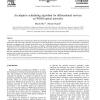113
Voted
TDSC
2010
14 years 7 months ago
2010
Automated, rapid, and effective fault management is a central goal of large operational IP networks. Today's networks suffer from a wide and volatile set of failure modes, wh...
122
Voted
ICC
2009
IEEE
14 years 10 months ago
2009
IEEE
Link protection schemes for WDM-based optical networks have been extensively researched. Most work to date has ignored the physical layer impairments (PLIs) that could be dominant ...
104
Voted
NETWORKS
2010
14 years 11 months ago
2010
Maˇnuch and Stacho [7] introduced the problem of designing f-tolerant routings in optical networks, i.e., routings which still satisfy the given requests even if f failures occur...
106
click to vote
INFORMATICALT
2010
14 years 11 months ago
2010
We address the issue of inapproximability of the wavelength assignment problem in wavelength division multiplexing (WDM) optical networks. We prove that in an n-node WDM optical ne...
126
Voted
NETWORK
2007
15 years 9 days ago
2007
Passive optical networks are a prominent broadband access solution to tackle the “last mile” bottleneck in telecommunications infrastructure. Data transmission over standardiz...
119
click to vote
IPL
2002
15 years 14 days ago
2002
In studying the scalability of optical networks, one problem which arises involves coloring the vertices of the n-cube with as few colors as possible such that any two vertices wh...
102
click to vote
CN
2000
15 years 19 days ago
2000
The performance of packet-switching wavelength routed optical networks critically depends on packet contentions at the intermediate routers. This paper shows through simulations t...
106
click to vote
COMCOM
2004
15 years 19 days ago
2004
One of the important issues in the design of future generation high-speed networks is to provide differentiated services to different types of applications with various time const...
102
click to vote
TON
2008
15 years 21 days ago
2008
Traffic grooming in optical networks has gained significance due to the prevailing sub-wavelength requirement of end users. Optical networks get upgraded to the latest technology s...
PE
2008
Springer
15 years 22 days ago
2008
Springer
One of the major concerns in optical networks is the bandwidth underutilization problem. In fact, as WDM technology keeps maturing, there is a bandwidth gap between the transmissi...





